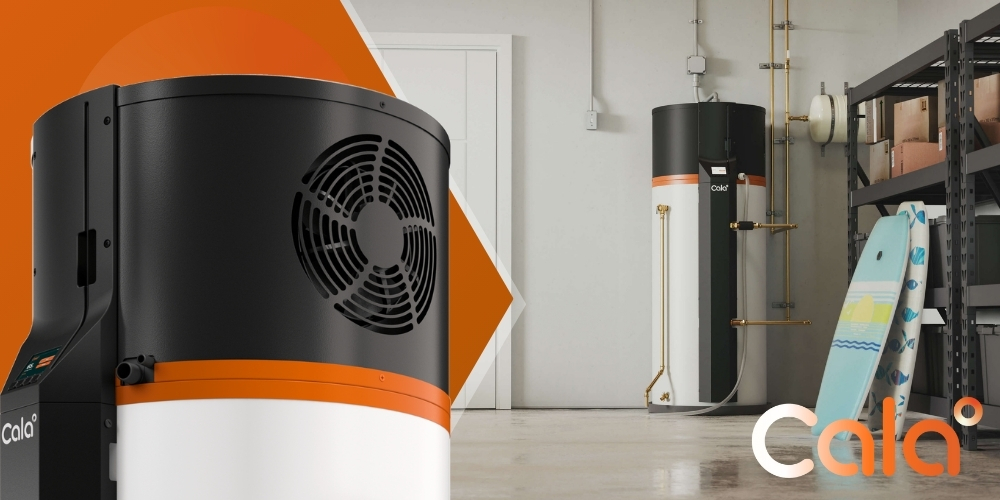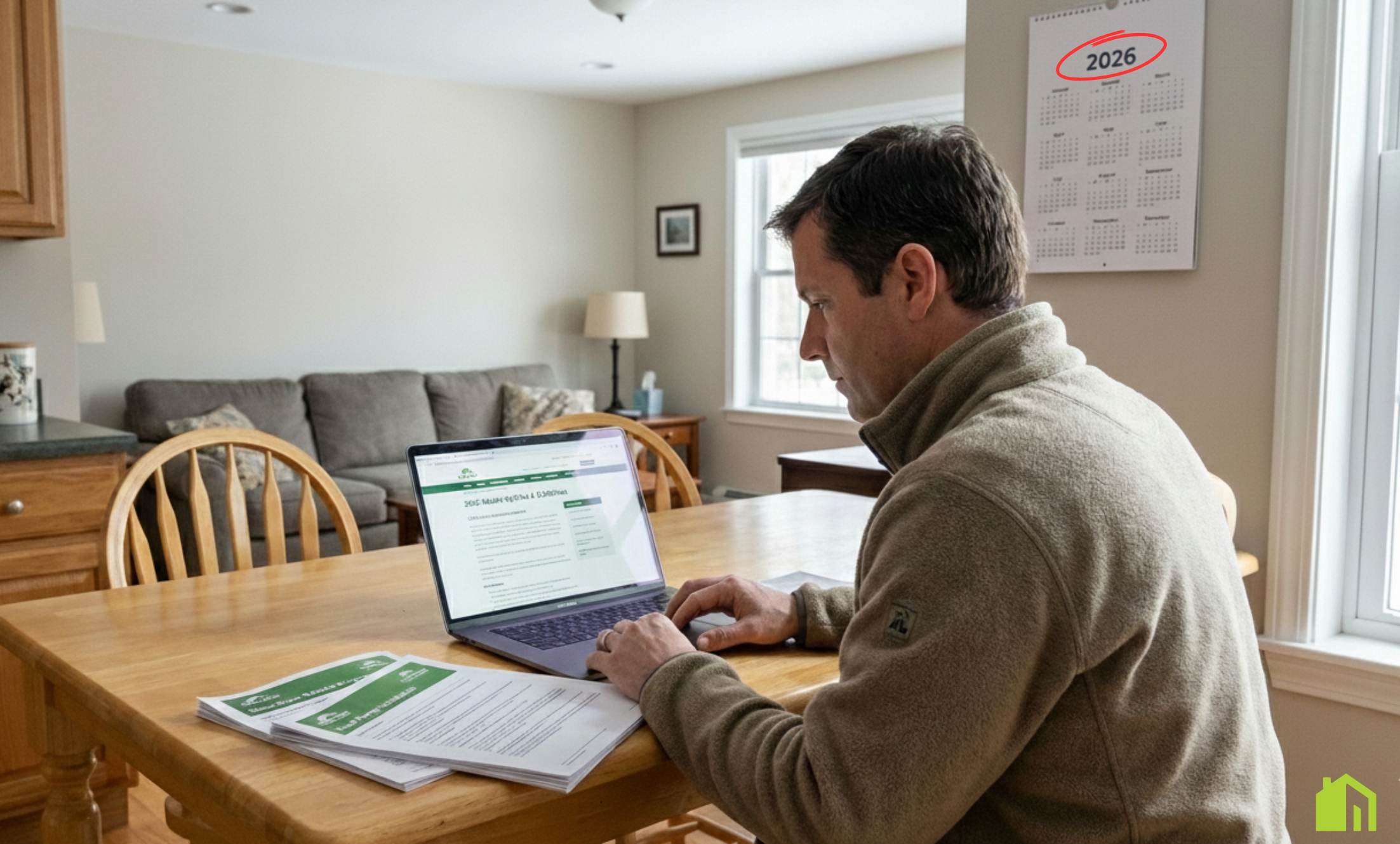What to Expect During a Thermostat Replacement Appointment

Intelligent Heat Pump Water Heaters for Massachusetts Residential Homes — Why SumZero Selects Cala
By SumZero Energy Systems — Massachusetts’ #1 Heat Pump Installation Team
Picking a new water heater once involved a simple decision between gas and standard old electric, praying the hot water wouldn't be gone when there were two showers in a row. That's no longer the case. Now, the ideal solution for the majority of Massachusetts homes is a smart heat pump water heater (HPWH). This isn't the typical hybrid of which you might have heard, but a rather new breed of unit that adapts to your home's schedule, accommodates your energy usage, and maintains comfort consistently while consuming a lot less energy.
When homeowners want to have it exactly right the first time, our team is discerning about what products we choose. We consider the landscape and inspect the details before determining that they might work with Cala, a company that produces a high-technology hot water heater that modern homes need: intelligent, consistent, and efficient hot water — installed properly. This article describes why this alliance matters, how the tech benefits your home, what you should expect from our installation, and the handy information (rebates, credits, fit questions) homeowners inquire about daily.
Why This Alliance Is Important
(and What It Does for You)
There are two parts to a successful hot water solution:
Great technology
A system that makes you comfortable and uses less energy.
Great installation
Design, placement, airflow, electrical, condensate handling, commissioning, and long-term support.
Cala provides a tailor-built, smart HPWH platform. SumZero provides actual-world experience so that it works perfectly in real Massachusetts homes.
Together, we provide three things homeowners report wanting:
Accurate hot water at peak periods without guessing.
Cheaper monthly energy bills without compromise on comfort.
It is a future-proof solution that addresses the trend towards greener, all-electric homes.
Simply put: We get hot water. We know how to properly install heat pump technology. This combination makes a water heater upgrade a smart, long-term decision.
The Homeowner's Dilemma That We Are
If you have had a gas or a typical electric water heater, then you know the problems:
Hot-cold swings on hectic morning routines.
Higher electricity bills than hoped for.
No real insight, no real control.
A replace cycle that is experienced as "buying the same thing again."
Typical hybrid: Heat pump water heaters perform better, yet they still react: They delay until the tank cools off, then warm it up again. Homeowners averred they desire a system which thinks ahead—a unit which is a breeze to operate, handles peak load graciously, and does not make them compromise.
They fill that gap, which is why we work with them.

Why a Smart HPWH is Different
A standard electric water heater makes heat by passing an electric element, a giant toaster coil, through the tank. A heat pump water heater does it another way: it takes heat from the air it lives in and puts it into the water. Because it costs less energy to move heat than create it, heat pump water heaters run on much less power than typical electric ones. And they avoid burning gas, venting, and pollution.
A smart HPWH goes one step further:
It adapts to your home's schedule (morning showers, nighttime laundry) and preheats when demand isn't yet high.
You can use the app to check, plan, or increase hot water whenever you want.
It has a compressor that can change speed to fit what you need (not just "on/off").
It is achievable with a mixing valve holding water at the proper warmth for improved efficiency and then providing a sustained, safe warmth for usage. This is also possible with the availability of additional warm water at peak usage times.
It goes nicely with a contemporary home — primed for solar, time-of-use, and information you can view at a glance.
Result: more stable comfort, less energy use, improved control.
Why a Smart HPWH is Different
From what is visible on-site, there are three things certain for homeowners regarding the points of Cala:
1) Ease That Is Effortless
Consistent hot water at peak use is the ultimate test. Through forecasting demand and using a mixing valve, Cala maintains a steady supply. That results in less "uh oh" when two showers coincidentally happen at once or someone turns on the dishwasher.
2) Controls That You'll Ever Use
App functionality is key when done properly. You can check if there's hot water, turn up the heat for guests, view energy usage history, or simply set it and leave. As installers, we appreciate performance data — it allows us to address little issues before large ones form.
3) Future-Ready from Day One
Massachusetts is going towards clean, electricity-based homes. Cala's strategy combines well: it is scalable for solar power and accounts for time-of-use rates when needed. If you foresee solar energy at some time, or already have it, this water heater won't stop your home from being efficient.
4) A Company That Stands Behind Its Product
Cala backs every unit with a 10-year parts warranty and 3-year labor warranty — a strong sign they stand behind both the technology and the people who install it. At SumZero, we respect that kind of commitment because it mirrors our own approach: taking care of homeowners and supporting our partners with the same level of trust and accountability.
What SumZero Offers As Your Installer
(Why It Matters)
Even the best system won't work so great if installed wrong. Our task is getting your new HPWH working perfectly inside your home, not on a drawing board. This is what our approach is:
Right-size design.
We measure how much water your home needs and discuss the high-flow fixtures, filling bathtubs, and washer usage.
Best installation and ventilation.
HPWHs require air to make the heat move. We consider the room size, doors, vents, and — when necessary — ducting solutions for high performance and low noise.
Clean handling of electricity and condensate.
Safe power, tidy routing, and a trustworthy drainage plan are essential.
Commissioning correctly.
We don't just "turn it on." We verify performance, position the mixing valve, help you with the app, and verify your comfort objectives.
Rebates, credits, and financial assistance.
Mass Save, federal 25C, and the 0% HEAT Loan (if applicable) — we'll help you with that.
We take special care.
Our teams respect your home, protect your floors, and leave the place nicer than they found it.
Aftercare you can count on. Questions years down the road? We're here. The whole concept of a smart system is long-term confidence, not a one-day installation.
Costs, Incentives, and Lifetime Value
Two parts matter here: upfront cost and operating cost.
→ It is a better unit than a standard electric or simple hybrid. Tax credits and rebates make a big difference. A lot of Massachusetts homeowners rely on the 0% HEAT Loan for easier payments.
→ Month after month, the intelligent HPWH's effectiveness is where the value lies. By transferring (not creating) heat and by scheduling heating intelligently, homeowners consistently experience significant decreases in water-heating energy consumption — particularly relative to resistance electric, and many times relative to gas or delivered fuels when full costs are factors.
If you'd like figures specific to your home (household number, showering usage, energy costs), we'll do the math at your consult and provide you with a clear estimate of payback, lifetime cost saving, and the rebates for which you qualify.
Are Smarter Heat Pump Water Heaters Good for Your Home?
It is feasible for many Massachusetts homes. We will cover:
→ Household size and routines. Families with up to about 5 people usually do well with the standard setup; we will give advice for larger families or special situations.
→ Space and ventilation. We check the space, door vents, or ducts if necessary, and ventilation so the system operates properly.
→ Location. Basements are typical, as are utility rooms. As the unit functions, it removes air that feels like a dehumidifier — a typical plus for basements.
→ Electrical. We check panel capacity and proper wiring; no installation day surprises.
→ Future plans. Now or in the future for solar? Time-of-use rates? We'll put the system on so it grows with your home.
[[cta-heatpump]]
Why Is Cala Different from "Traditional Hybrids"?
✪ Control and Convenience:
Cala integrates intelligent tech with a mixing valve to remain comfortable, even when it is busy. Most standard hybrid units have simple modes and react only when the tank becomes chilled.
✪ Care and Trust:
Performance insights help you recognize problems early on and keep you on your feet for surprises. Traditional deployments are mostly "wait and see."
✪ Timing and Efficiency:
Variable driving and improved scheduling assist in energy saving with the maintenance of comfort. Ordinary hybrids operate more often and at undesirable times.
✪ Future-Ready
The design of the Cala accommodates with solar power, intelligent homes, and plans for utilizing electricity. Most older hybrids were not built for that usage.

What to Expect with SumZero
(From the First Call Through the First Shower)
✪ Talk & Pictures
We'll first glance at your objectives and take some fast photos of the current installation: the water heating unit, panel, and surrounding room.
✪ Right-Fit Design
We fit your hot water consumption and available spaces to a design which we endorse.
✪ Chaplain: A Comprehensive
Your quote is going to be transparent, includes information for installation, accessories, and a checklist for incentives. The paperwork assistance takes care of our end.
✪ Professional Installation
Licensed, insured, and detail-orientated. We dispose of the old unit, prepare the site, install and commission a new system, and leave the site tidy.
✪ App Introduction and Instructions
You'll discover how to see hot water supply, schedule increases, and view consumption — without being "technical."
✪ Support and Help
We're your long-term partner. Got a question? You call us — that's what homeowners deserve from the #1 heat pump installation company.
Common Questions We Get
(And Easy Answers)
Smart heat pump water heaters move heat from the surrounding air into the water instead of generating heat directly. This makes them up to three to four times more efficient than standard electric models. Cala’s intelligent system takes it further — it learns your household’s patterns, preheats before busy periods, and gives you app-based control to monitor or boost hot water anytime.
Most hybrid water heaters react when the tank cools. Cala predicts when your home will need hot water and heats proactively, saving more energy while maintaining comfort. It also features a variable-speed compressor, integrated mixing valve, and performance monitoring portal, giving both homeowners and installers a smarter, more reliable experience.
Savings depend on your energy source and usage, but many Massachusetts homeowners cut their water-heating costs by 50–70% when switching to a heat pump system. Cala’s intelligent controls add even greater efficiency. Add Mass Save® rebates, federal 25C tax credits, and potential 0% HEAT Loan financing, and most families see real payback within just a few years.
Yes — most Massachusetts homes are a great fit. Cala’s 65-gallon design comfortably serves households up to five people and can prepare up to 90 gallons ahead of peak use. The system needs adequate space and airflow, similar to a dehumidifier, and our team at SumZero handles every detail — from placement and ducting to electrical and performance checks.
SumZero Energy Systems is Massachusetts’ #1 heat pump installation team, trusted for precision, transparency, and high-quality service. We manage every step — design, installation, rebate paperwork, app setup, and long-term maintenance — so homeowners enjoy smarter comfort and lasting confidence. With SumZero, you’re not just buying equipment; you’re gaining a partner who stands behind it.
Why We Feel Secure Recommending This to Massachusetts Homeowners
We have a simple promise: we only install solutions that we would use in our own homes. Cala’s approach — being smart, having control, and being ready for the future — matches what we have learned from many talks with homeowners in the state. Together with SumZero’s careful installation standards and ongoing support, this water-heating upgrade makes sense right away and will last well with your home. Cleaner heat. Smarter comfort. Fewer bills.
Ready to Take the Next Step?

To learn more about Cala’s technology and vision, visit Cala Systems.
What to Expect During a Thermostat Replacement Appointment
If you’re a homeowner in Massachusetts considering a thermostat replacement, you're likely aiming for better comfort and more control over your indoor climate. Whether you're upgrading to a smart thermostat or replacing an outdated unit, knowing what the appointment involves can make the process smooth and stress-free.
Replacing your thermostat is much more than a plug-and-play task. It’s a small piece of technology with big effects on your comfort, energy use, and even your savings. Here's what really happens during the appointment—and why it’s worth considering sooner rather than later.
Getting Ready: What Happens Before Installation
Before anyone touches your thermostat, there are a few things that typically happen to prepare your home and system. These early steps are all about ensuring the installation goes smoothly and supports your long-term HVAC performance.
Your HVAC System Inspection
The first step is a quick inspection to identify the type and compatibility of your current HVAC system. This step matters because the thermostat must match your heating and cooling system to function correctly.
- Inspect the existing HVAC unit
- Confirm compatibility with the new thermostat
- Check for any potential wiring or power issues
One overlooked step in thermostat replacement is verifying that your wiring supports advanced features—skipping this can limit how your Wi-Fi thermostat performs.
Choosing Your New Thermostat
Next comes selecting a thermostat that aligns with your lifestyle, system, and local energy efficiency goals.
Here are the popular thermostat options for Massachusetts homes:
- Programmable thermostats: Set schedules based on your routines
- Smart thermostats: Learn and adjust settings automatically
- Wi-Fi thermostats: Control from your phone or voice assistant
The goal here isn’t just functionality—it’s energy savings. If your thermostat can reduce your system’s workload while maintaining comfort, you’ll see the benefits in both performance and cost over time.
The Day of Your Thermostat Replacement Appointment
Once your system is assessed and the replacement thermostat selected, here’s what typically happens on appointment day. This part of the process is relatively quick, but it's crucial for setting your home up for smarter, more efficient comfort.
Powering Down for Safety
Before anything else, your HVAC system will be powered off to ensure safety. Thermostats deal with low-voltage wiring, but even that poses risks if handled incorrectly.
- Shut off power from your circuit breaker
- Remove the old thermostat without damaging wall or wiring
- Label existing wires to match with new terminals
Installing the New Thermostat
Mounting the new thermostat and making the wiring connections typically takes under an hour. However, extra time may be needed if you're integrating advanced features.
- Connect labeled wires to terminals in the new unit
- Mount thermostat flat to the wall for proper sensor readings
- Restore power and test for operational issues
This is when your thermostat essentially becomes the “brain” of your HVAC system, with upgraded features like geofencing, remote access, or automated schedules.
Homes in Massachusetts can save up to 10% annually on heating and cooling bills just by using a smart or programmable thermostat correctly, according to Mass Save®.
[[cta-heatpump]]
Custom Setup and Walkthrough
Once installed, your thermostat gets configured according to your preferences. This is also when any mobile apps or features like voice integration are set up.
Expect support during this phase with:
- Setting temperatures for different times of day
- Activating automatic, learning, or vacation modes
- Syncing with Wi-Fi and verifying app access
Many Massachusetts homeowners appreciate having quick access to local weather updates, energy reports, and comfort adjustments—all from their phones.
After the Appointment: Getting the Most from Your Upgrade
Now that your smart thermostat installation is complete, it’s time to optimize how it works for your household. How you use your new thermostat will impact its performance and your wallet.
How to Maximize Energy Savings
Even advanced thermostats need proper programming to deliver on energy-efficient promises.
Follow these tips:
- Use a schedule: Set consistent temperature cycles based on your work and sleep habits
- Take advantage of eco modes: Lower temperature automatically while you're away
- Enable reminders: Some devices suggest maintenance like filter changes or efficiency tips
Small adjustments—like dropping temps by a few degrees at night—can add up. The key is consistency.
Monitor and Adjust as You Go
Your first week with a new thermostat is about learning. Not only will it start understanding your patterns (for smart models), but you’ll also get a feel for how the features work.
Expect these insights:
- Weekly energy reports (if supported by your unit)
- Room-by-room usage diagnostics (on some models)
- Seasonal efficiency recommendations
Thermostats with learning algorithms can reduce energy waste without you lifting a finger—but they work best when tailored to your schedule.
Consider the Bigger Picture: Your HVAC System
The condition of your HVAC system plays a key role in how well your new thermostat performs. If your system is older or inefficient, even the smartest thermostat can only do so much.
That’s why many homeowners consider upgrading to a high-efficiency unit, or checking their system’s SEER rating, when replacing the thermostat. Matching efficient hardware with smart controls brings the highest return on comfort and cost savings.
Here’s what works well with modern thermostats in Massachusetts:
- Mitsubishi Electric heat pumps for consistent warmth in winter
- Bosch HVAC units with variable-speed features
- Daikin and Samsung systems compatible with advanced Wi-Fi thermostats
These integrations can unlock features like zone control, humidity monitoring, or responsive heating that adjusts based on outdoor temperature.
Is a Thermostat Upgrade Right for Your Home?
If you’re dealing with fluctuating temperatures, rising energy bills, or outdated wall controls, a comfort upgrade can be a simple fix. Thermostat replacement is a small project with big benefits—especially when paired with today’s energy programs available in Massachusetts.
With the right thermostat setup, you’ll enjoy:
- Better temperature control throughout your home
- Lower heating and cooling costs over time
- Less wear and tear on your HVAC system
- Convenient comfort adjustments from anywhere
Before your next heating season arrives, consider making the switch to a programmable thermostat or a smarter control option. It’s a quick, cost-effective improvement that Massachusetts homeowners can count on year-round.
Take control of your indoor climate with our expert thermostat replacement services—designed to boost comfort and maximize energy savings for Massachusetts homeowners.
Upgrade Your ThermostatYou Might Also Like…
Continue learning with handpicked articles that inform and inspire.
Not Sure Where to Start? We’ll Guide You
Let our experts design the right heating and cooling solution—customized for your comfort, your layout, and your energy goals. No pressure. Just clarity.
Request FREE ESTIMATE









